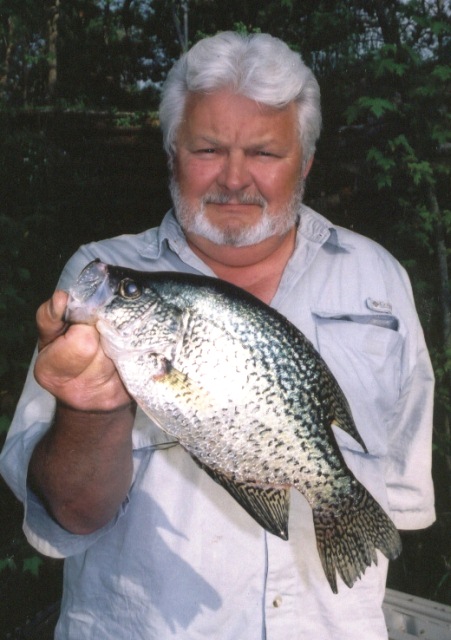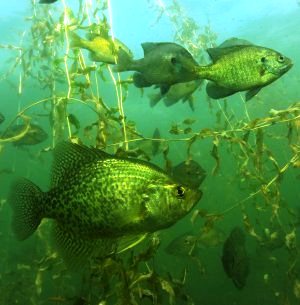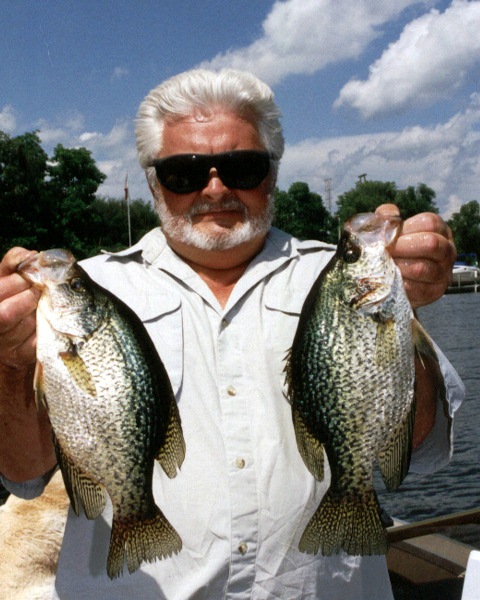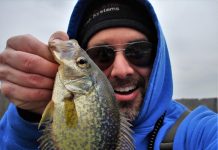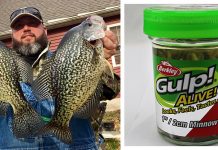Lake Wisconsin is known as a good lake for walleyes, saugers, crappies, and muskies especially in the spring and early summer before the algae bloom arrives. The lake is over 9,000 acres and stretches from the dam at Wisconsin Dells to the last dam on the Wisconsin River at Prairie du Sac. Lake Wisconsin is an excellent fishery for many different fish species. The lake also has an abundant number of bass (largemouth and smallmouth), white bass, catfish, drum, sturgeon, and of course, bluegills.
When I’m fishing Lake Wisconsin, I usually fish for walleyes and saugers. But, a few seasons back, I decided to experiment on the lake. First, I’ll backtrack and tell how a few years ago; I discovered by chance a different method for catching “slab” crappies. At least, it was a different technique for me. Most years, anglers wait anxiously for the ice to melt, so that they can fish for the early and pre-spawn walleyes and saugers at the north end of the lake near Tipperary Point, where the lake narrows and heads toward Wisconsin Dells. The walleye fishing is usually good till middle or late July, when the normally stained waters turn green with an algae bloom that can last till the fall. The fishing, particularly the walleye fishing, can get tough during a hot August.
A few June’s ago, I was fishing Lake Wisconsin for walleyes and was pleasantly surprised. The water temperature was close to 70 degrees. The lake was its normal stained coffee color and the green algae was just starting to appear. Early in the season, I use jigs and live bait (minnows) or some live bait rig (Lindy or Roach rig) to catch walleyes and saugers.
As the weather warms, I switch my live bait presentations from minnows to night crawlers and leeches. I present these baits by back-trolling over structure (usually wood, mud, or rock), slowly working my rig or jig while on my bow-mount Minn Kota trolling motor, or drifting the structure if the wind conditions are right. These methods work well on the lake from early spring through the middle of summer. Then, open-water trolling takes over and most anglers spend their fishing time by trolling crank-baits through the lakes many stump fields, points, and breaklines. The local’s main trolling presentation is pulling Rapala Shad Raps (# 5 and # 7’s) in fire-tiger, blue/orange, and black/chrome through the scattered wood and structure. Most of this water is 10 to 20 feet deep and you ideally want your crankbait to be touching bottom and bouncing off wood and the bottom to trigger strikes. When I troll, I always use Off Shore planer boards (OR-12) to get my crank baits away from the boat to avoid spooking the fish and also allowing me to cover more water with my baits. In Wisconsin, it is legal to use 3 rods per person. So, with 2 people in the boat you can legally have 6 lines in the water. This means you could legally run 3 boards on each side of the boat. This would allow you to cover a wide path and cover lots of water, but with the abundant wood stumps that are scattered randomly, one would spend too much time getting caught in the wood and losing lures. So, the best way I’ve found to fish Lake Wisconsin with a friend is to use only two planer boards per side and one flat line straight out the back of the boat. This way you’re using 5 lines instead of 6, but you’ll get caught less, lose less lures, and spend more time fishing. I stagger my lures from the bottom to the top of the water column till I start catching fish at a certain depth. After catching a few fish at the same depth, I’ll switch a couple more rods to that active depth. I also watch my electronics for schools of baitfish and schools of fish.
This set-up is what I normally use when fishing Lake Wisconsin during the summer. But, a funny thing happened to me a few seasons back while fishing the lake. The “bible” or guide for people who troll is “The Precision Trolling book”, which says that a # 5 Rapala Shad Rap goes down 10 to 11 feet if trolled with 100 feet of monofilament line out and a speed of 1.5 miles per hour. Speed is also a factor to consider and the best speed for me has been around 1.5 miles per hour. If you’re not getting fish, try varying your speed up and over 2.0 M.P.H. or even down to 1.0 M.P.H. or slower on a given day. Speed and the depth fish are at can vary from day to day or even from hour to hour depending on whether or not the fish are actively feeding. The wind direction and your speed, and of course the weather also are important factors. Walleyes, which I was targeting, usually don’t suspend in Lake Wisconsin or I thought that they didn’t. The lake also doesn’t stratify, so there is no thermo cline. The fish caught are usually on the breaks, drop-offs, stumps, and near roaming schools of forage.
While trolling thru the wood and stump fields, I had a planer board slide back indicating that I had a fish on that crank bait. Upon reeling my bait in with some pressure from the fish, I was amazed to see that the fish was not a walleye, but a big crappie. To me a big crappie is over 12”, but this fish was 15” and fat. I continued trolling and soon I and a friend had 2 fish on, one on each side of the boat. Again, I had 2 more crappies, another 15” fish and a 13” fish. I was still using the same crank baits that I use for walleyes, but I happened to find that big crappies were suspended in the wood and stumps. The crappies were suspended over deeper water and slightly above the walleyes in the water column. Again and again, I trolled the lakes deeper contours and anywhere that there was wood and stumps mixed in, we caught big crappies. I narrowed the trolling pass down to about mile and concentrated on the area where the crappies were most active. I ended up keeping a dozen crappies with all the fish over 12”. I caught a few smaller fish which my fishing partner, Pancake Bob Zownir of Madison, released with some of the bigger fish. Thinking that this might just be a one day bonanza, I had to go fishing the next day and try again for the big crappies! I did the same tactic that I used the day before, I trolled Shad Rap crankbaits thru the wood and guess what? The crappies were still there where I caught them the day before and in a few hours I again had over a dozen crappies that ranged from 11” to over 15”. Not to be one to walk away from a good bite, I returned for the third day in a row and again hammered the big crappies. For three days in a row, I was in crappie heaven and just by luck. A few days later, I fished “my’ area, but the crappies had moved like they regularly do. But, I try to cover a lot of water during the summer and have found suspended crappies many other times using this tactic.
During the spring, many anglers fish and catch Lake Wisconsin crappies by fishing the shallow water with slip floats, plain hooks with live bait, jigs/plastics, and tube jigs tipped with a lively crappie minnow. Fishers concentrate on the many bays and inlets where the water is calm, quiet, and warming. But, after the spring bite few anglers fish for crappies because they aren’t in the shallow water anymore. These big crappies go into a summer pattern toward the middle or end of June. Then, they continually move around the wooded and deep areas of Lake Wisconsin chasing bait fish and suspending. I’m positive that Lake Wisconsin’s big crappies that can be caught all summer long, if you try to use this summer technique.
Experimentation and a little luck can often help you find that “honey hole”. But, you have to put your time in on the water and keep experimenting, especially if the fish aren’t biting. Though, walleyes were what I was after, sometimes things change or you get lucky and find something else that works on the water that you’re on. I’ll never again consider Lake Wisconsin just for walleyes, because when fishing, different scenarios pop up, so take advantage of what’s biting when fishing. Flexibility and experimentation can often be the key!

